The Importance of Grip Tape in Skimboarding Performance


Intro
When you think about skimboarding, the first things that might come to mind are the rush of catching waves, the thrill of riding, and, of course, the resilience needed to master the art of gliding. Yet, nestled quietly among these factors is an essential element that plays an equally crucial role: grip tape. Often overlooked, grip tape transforms a skimboard from a mere piece of wood into a serious tool for performance and safety.
Grip tape isn’t just a sticky accessory; it’s the unsung hero that directly influences a rider’s grip and control. Various types exist, and each has its own applications and nuances that skimmers need to consider. Whether you’re a novice just getting your feet wet or an experienced rider tackling more formidable surf, understanding the importance of grip tape can elevate your skimboarding experience to new heights.
The right grip tape enhances rider safety by reducing the chances of slipping, especially in tricky wave conditions. A reliable grip allows a skimmer to execute maneuvers with greater confidence, paving the way for progression in their surfing skills. Furthermore, installing the tape properly and learning about its upkeep can lead to longer-lasting performance wins.
In this exploration, we'll journey through the varied landscape of grip tape for skimboards, including expert opinions and personal insights from seasoned skimboarders. We’ll also discuss environmental considerations regarding grip tape selection, which is becoming more relevant in today's conscious consumer market. So buckle up as we delve deeper into the mechanics of this often-ignored aspect of skimboarding.
Understanding Grip Tape
Grip tape is not merely an accessory for skimboarding; it is the cornerstone of control, safety, and performance. When tailored precisely to the rider and conditions, grip tape can elevate the skimboarding experience from mediocre to thrilling. The relationship between the skimboarder and the grip tape is often overlooked. Yet, understanding grip tape is essential for anyone serious about the sport. It influences maneuverability, stability, and even the overall enjoyment while gliding across the water.
Defining Grip Tape
At its core, grip tape serves as an adhesive surface applied to the deck of a skimboard. This textured material, typically made of a robust sandpaper-like substance, provides friction, ensuring that the rider’s feet remain firmly planted during intense movements and landings. Without grip tape, a skimboard would be a slippery platform, reminiscent of surfing on a wet bar of soap—not exactly ideal for precision riding.
Various kinds of grip tape are available on the market. Some are designed specifically for skimboarding, while others have applications in skateboarding or longboarding. The different formulations of grip tapes cater to varying preferences in texture and feel, allowing riders to select something that aligns with their unique style.
Historical Context
The evolution of grip tape is an interesting tale. It all started decades ago, primarily in skateboarding; riders needed something to keep their feet on the board as they executed tricks. As skimboarding gained popularity, the transfer of innovations from skateboarding became natural. Early enthusiasts experimented by using different materials, from rubber soles to sheets of sandpaper, until they settled on specialized grip tape. This transition was pivotal, as riders quickly recognized that having reliable grip separated the average from the exceptional on the skimboarding scene.
Significantly, the development of grip tape has also paralleled advancements in skimboard construction. With the introduction of lighter and more durable materials, new grip tape formulations emerged to better complement these boards.
"The right grip tape can be the difference between a great ride and a wipeout."
— A seasoned skimboarder discussing the importance of grip tape.
By understanding both the definition and the historical context of grip tape, riders can appreciate its significance on the water and make more informed choices when selecting the right type for their adventures. The next sections will explore the various types of grip tapes and their unique advantages.
Types of Grip Tape
Understanding the various types of grip tape is crucial for any skimboarder, whether you’re just starting out or you’re a seasoned pro. Grip tape is not just a simple accessory; it plays a vital role in how well you can maneuver your board. The grip tape you choose can directly impact your performance and comfort on the water. Let’s delve into the different types that cater to specific needs, ensuring you have the best grip possible for your riding style.
Standard Grip Tape
Standard grip tape is the go-to choice for many skimboarders. It provides a solid surface that’s designed to enhance traction between your feet and the board. This type of tape is typically made from a rough, sandpaper-like material, allowing for excellent grip on smooth or wet surfaces. It’s reliable and can withstand various environments.
When choosing standard grip tape, there are a few things to consider:
- Texture: A rougher texture will provide more grip, which is essential for performing tricks.
- Thickness: Thicker tapes often absorb shocks better, which can lead to a more comfortable ride.
- Durability: Opt for brands known for their longevity, especially if you frequently skim in harsh conditions.
Many riders appreciate the straightforward performance that comes from standard grip tape, but it’s not one-size-fits-all, as various factors may necessitate a different style.
Anti-slip Variants
Anti-slip grip tapes are another excellent option. They’re specifically designed to offer maximum traction, even in slippery conditions. These variants often incorporate unique textures or materials that give them a grip that is almost unbeatable. This is particularly beneficial for skimboarding when you might encounter wet sand or waves.
Key features to look for in anti-slip variants include:
- Enhanced Adhesiveness: This keeps the tape securely in place, reducing the chance of it peeling off during your ride.
- Variable Texture: Different textures can be found, some offering a softer feel, while others provide a firm grip with minimal give.
- Water Resistance: Important for those who skimboard in unpredictable weather; ensure your anti-slip grip tape is water-resistant to maintain its efficacy.
Opting for an anti-slip variant can significantly bolster your confidence while riding, knowing you won’t lose your footing in challenging conditions.
Eco-friendly Options
In today’s eco-conscious world, many skimboarders are looking for ways to minimize their environmental impact. Eco-friendly grip tape options are now available and made from sustainable materials that reduce waste and environmental harm.
These are the standout aspects of eco-friendly grip tape:
- Biodegradable Materials: Opt for tapes that can break down over time without leaving harmful residue.
- Non-toxic Adhesives: Made with safe, non-toxic adhesives that won’t release harmful chemicals into the environment.
- Durability: While it’s crucial to be eco-friendly, this shouldn't come at the cost of performance; many eco-friendly options are just as durable and effective as conventional grip tapes.
Choosing eco-friendly alternatives not only helps the planet, but also reflects a modern awareness about the materials we use in our sports.
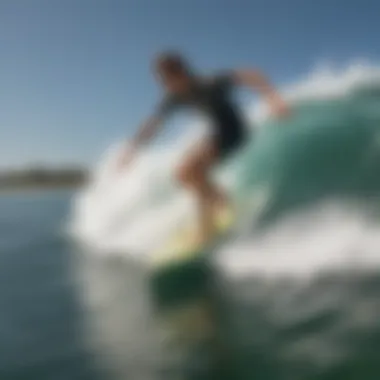
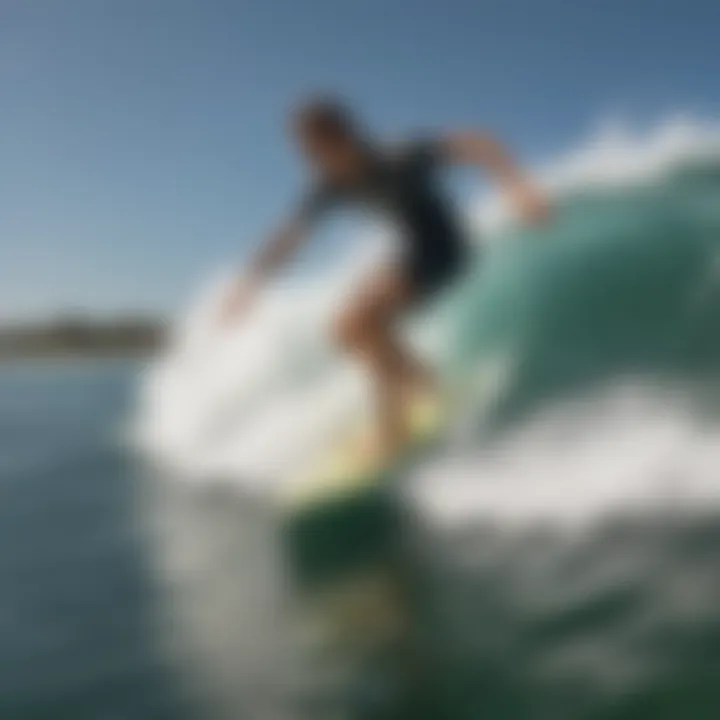
Remember, skimming with the right grip tape can elevate your entire experience, providing both safety and performance boosts, whether you are gliding over gentle waves or tackling challenging tricks.
Understanding these types of grip tape lays the foundation for making informed choices that can make a significant difference in your skimboarding adventures.
Importance of Grip Tape in Skimboarding
Grip tape might seem like a simple accessory, but its significance in skimboarding goes well beyond just aesthetics. Riders often overlook it until they’re slippin’ and sliding off their boards, and by then it’s usually too late. The role of grip tape can’t be overemphasized. It serves as the essential bond between the rider's feet and the board, critical for control, safety, and overall performance. Let’s dive deeper into each element that demonstrates its importance.
Enhancing Control
Every experienced skimboarder knows that having precise control over the board can make or break a ride. Grip tape enhances control by providing traction, allowing the rider to shift their weight intelligently during maneuvers. Without proper grip, spins and slides can turn into unintended wipeouts.
Consider this: when a rider is executing a quick turn, having a secure grip means they can shift their balance seamlessly. A high friction surface stops feet from sliding around on the board, especially in challenging conditions—wet sand or slippery water surfaces.
Moreover, riders looking to perform intricate tricks can significantly benefit from a good grip. Tricks like spins, ollies, and even aerials demand substantial foot autonomy on the board. If the grip tape loses its texture, it can feel like trying to dance on ice, where one miscalculation could result in a fall. A high-quality grip tape easily amplifies control and instills confidence, making every move feel like second nature.
Ensuring Safety
Safety is paramount in any sport, and skimboarding is no different. Proper grip tape plays a key role in simplifying this safety aspect. When you have reliable traction, the likelihood of slipping off the board—especially at high speeds or on uneven surfaces—is drastically reduced.
"The right grip tape can turn a bumbling novice into a more competent rider with just one change."
This isn’t just about preventing accidents; it’s also about promoting a safe experience where riders can push their limits without the constant fear of losing control. Victories and tricks transform into highlights instead of unsavory getting-up-from-a-fall moments. Also, considering the potential hazards of hard surfaces, ensuring your feet stay connected with the board is a small price for the peace of mind it offers. Every foolhardy ride deserves a grip that can back it up!
Impact on Performance
Grip tape has a direct impact on performance in terms of how effectively a rider can execute their style. From seasoned pros to eager beginners, the right grip can elevate performance levels significantly. Whether on flat surfaces, in the surf, or executing tricks, optimal grip taping allows riders to harness and maximize their abilities.
Different types of grip tape can influence the performance based on the rider’s preferences too. While some riders prefer a softer grip for more cushion during landings, others might opt for a course texture to ensure their feet stay locked during intense movement.
Additionally, the environmental factors like sand quality, moisture levels, and even types of waves will interact differently with various types of grip tape. A rider who understands these dynamics can tailor their setup—resulting in enhanced performance and a more enjoyable skimboarding experience. When the board and rider work in harmony, it creates a flow that just feels right.
In summary, grip tape is integral to the skimboarding experience. Its ability to enhance control, ensure safety, and impact overall performance makes it a topic worth paying attention to for anyone looking to ride better and ride safer.
Choosing the Right Grip Tape
Selecting appropriate grip tape for skimboarding is a fundamental aspect that can greatly influence both performance and safety for riders. The right grip tape enhances control, assures security during tricks, and accommodates varying conditions that a skimboarder encounters. As the riders navigate the waves or glide along the beach, having the proper grip tape is akin to having the right tires on a car— it ensures smooth handling and an overall enjoyable experience.
Considering Skimboard Material
Skimboards are usually made from materials like wood, fiberglass, or foam, each requiring a different kind of grip tape for optimal adhesion and performance. For instance, a wooden skimboard benefits from a thicker grip tape that can endure the wear and tear from sandy conditions. Fiberglass boards, on the other hand, often require a finer grip tape to maintain a strong bond without scratching the surface. When considering the material of your skimboard, it's crucial to ensure compatibility with the grip tape to avoid issues that could hinder your performance.
For example:
- Wooden Boards: Thicker grip tape for durability
- Fiberglass Boards: Finer grip for preventing scratches and improving grip
- Foam Boards: Lighter grip tape that still provides adequate grip without adding weight
Identifying the right kind of tape based on the skimboard's material can make all the difference when riding.
Evaluating Riding Style
Riding style is another key factor in deciding on grip tape. Skimboarders can vary from casual riders who enjoy serene oceanic rides to aggressive stunt performers executing tricks. Each style demands a distinct approach to grip tape.
Consider this: A rider who enjoys performing acrobatic moves may gravitate towards a grip tape with enhanced traction to facilitate quick foot adjustments. Conversely, a leisurely rider seeking smooth transitions might favor a softer tape that provides grip without feeling abrasive. When assessing your riding style, consider the following traits:
- Casual Riders: May prefer smoother, less aggressive tapes for a comfortable ride.
- Trick Performers: Generally, opt for aggressive grip tapes with high traction.
- Long-distance Riders: An eco-friendly, softer grip may help in comfort during longer rides.
Assessing Environmental Conditions
The final consideration when selecting grip tape revolves around the conditions in which you'll be riding. Skimboarding can occur in various environments, such as sandy beaches or rocky shorelines. Environmental factors, including moisture levels and the type of terrain, can determine the longevity and effectiveness of grip tape as well.
For instance:
- Riding in wet conditions calls for grip tape designed with a waterproof adhesive that ensures it will hold strong.
- Sandy beaches may require grip tape with a coarse texture to avoid slipping.
- In rocky areas, a more robust grip tape can withstand abrasion and damage.
Ultimately, understanding the environment where you’ll skimboard will guide you in selecting a grip tape that not only meets safety concerns but also optimizes your performance.
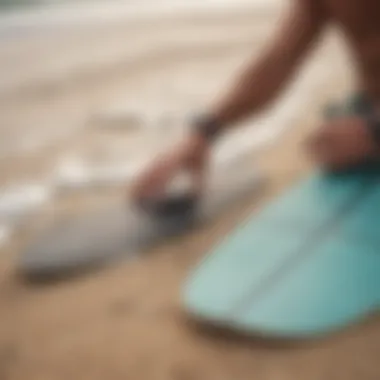
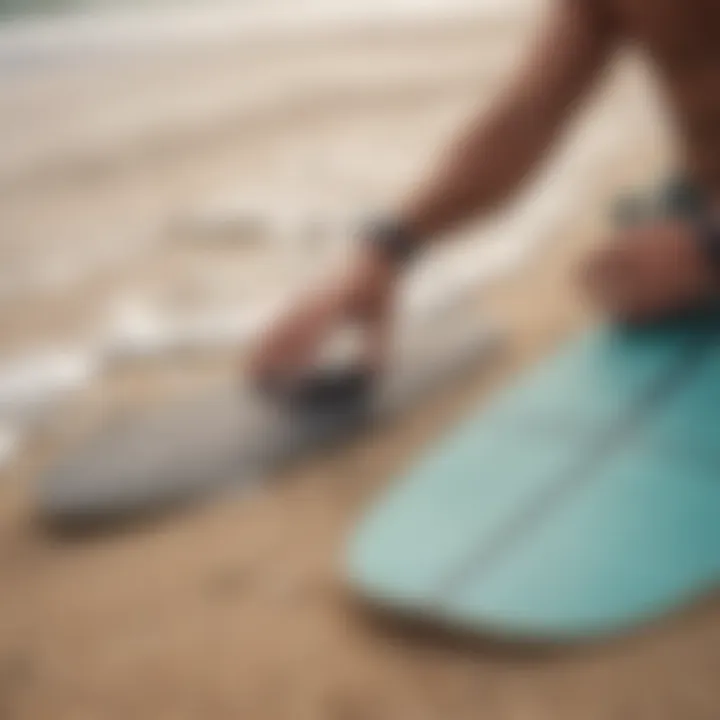
"Choosing the right grip tape isn’t merely a matter of preference; it can define the difference between a day of effortless rides and one filled with slips and falls."
By taking into account your skimboard material, riding style, and the environmental conditions, you'll be well-equipped to choose grip tape that enhances your experience on the waves. Armed with this information, skimboard enthusiasts of all levels can make informed decisions that lead to heightened enjoyment and safety on the water.
Installation Techniques
The installation of grip tape is a crucial process that can significantly affect a skimboarder’s performance and safety on the water. Getting it right means ensuring that the rider achieves optimal control, comfort, and response from the board. Proper installation also extends the longevity of the grip tape, saving the rider from recurring expenses and downtime due to necessary replacements. Understanding the steps involved is vital not just for seasoned skimboarders but also for beginners looking to enhance their skills and overall experience.
Preparation of the Skimboard Surface
Before applying grip tape, the first step is preparing the skimboard surface. This might seem straightforward, but skipping this can lead to poor adhesion and reduced effectiveness. Cleaning the board thoroughly is essential to remove any dust, sand, or oils that could interfere with the tape's stickiness.
- Choose the Right Area: Ideally, work in a clean, dry space to avoid dirt getting onto the board.
- Clean the Surface: Use a mild detergent and water to wipe down the area where the grip tape will be applied. After cleaning, let it dry completely.
- Inspect for Damage: Check for any minor dings or scratches. Repair these before proceeding, as they can lead to rough edges and affect the tape’s lifespan.
By establishing a clean and smooth surface, the grip tape will adhere better, making for a safer and more effective riding experience.
Applying Grip Tape
Once the preparation is out of the way, it’s time to apply the grip tape. This step requires a bit of patience and accuracy to ensure that the application is precise. It’s not just about sticking tape onto the board; it’s about placing it correctly for the best grip and functionality.
- Measure the Tape: Take the pre-cut grip tape and lay it out on your skimboard so that it covers the area of the board where you mostly place your feet.
- Peel and Stick: Begin peeling back a small section of the tape, about 6 to 12 inches. While peeling, make sure the rest of the tape doesn’t stick to anything else.
- Align Carefully: Place the tape on the board while slowly pressing down. The key here is to start at one end and work your way to the other, smoothing out air bubbles with a flat edge, like a credit card, as you go.
- Be Mindful of Air Bubbles: If any bubbles form, don’t panic. You can use a pin to poke a small hole on the inside of the bubble, then press it down to let the air escape.
If done correctly, the grip tape will lay flat, enhancing the rider's control on their board.
Trimming and Finishing Touches
After the grip tape is applied, the final step involves trimming the excess tape to fit snugly along the edges of the skimboard. This may seem minor, but it can have a big impact. Excess tape can peel over time or bunch up under a foot, leading to potential slip-ups.
- Use a Sharp Utility Knife: Carefully run the blade along the edge of the board to cut the tape. Ensure not to apply too much pressure so you don’t damage the board underneath.
- Smooth the Edges: After trimming, go over the edges with a finger or a small tool to ensure that the tape is flush against the board.
- Final Inspection: Check the applied grip tape for any loose ends or imperfections. Fix these immediately to prevent issues later.
"A smooth, well-applied grip tape can be the difference between a thrilling ride and a potential wipeout."
Taking the time to apply grip tape meticulously ensures a safer and better performing skimboard, providing confidence to enjoy every ride.
Maintenance of Grip Tape
Keeping grip tape in good shape is essential for a skimboarder aiming to maximize performance and ensure safety. Regular maintenance helps extend the lifespan of the grip tape, enhances rider control, and avoids unexpected slips while riding waves. This section covers key aspects of grip tape maintenance, including proper cleaning techniques, recognizing signs of damage, and knowing when to replace it.
Cleaning and Care
Maintaining the grip tape is not just about comfort; it's a critical aspect that can affect your performance out on the water. Dirty tape can accumulate sand, salt, and grime, making it less effective. To keep it clean, use a soft brush or cloth to remove visible debris. For a more thorough cleaning, mix a little mild soap with water and apply it with a sponge. After scrubbing, rinse it well to ensure all soap residue is gone and let it air dry completely. It's like giving your board a refreshing wash after a long day at the beach.
Identifying Wear and Tear
As a skimboarder, knowing what to look for in terms of wear can save you from surprises on the sandy shore or in the waves. Inspect your grip tape regularly; you want to be on the lookout for peeling edges, frayed or ripped sections, or a smooth, shiny surface that indicates it’s lost its texture. Any of these signs can compromise your grip and control. When you notice any of these wear patterns, it's time to think about either repairs or replacement.
When to Replace Grip Tape
So when should you make that call to replace grip tape? If you’ve thoroughly cleaned it and the damage is still evident, or if it no longer provides that satisfying stickiness that you rely on, it's time to swap it out. A good benchmark is to check your grip tape after every few rides—if things aren't feeling right or if the tape has developed serious wear, don't hesitate. Remember, safety comes first. A worn grip can lead to slips and falls that could have been avoided, so err on the side of caution. Replace your grip tape annually or sooner if you’re a frequent rider.
"Taking care of your gear can make the difference between a thrilling ride and a wipeout."
Impact on Skimboarding Techniques
Grip tape is like the unsung hero of skimboarding. Its role extends far beyond mere aesthetics; it significantly influences how riders perform their maneuvers in various wave conditions. The grip tape you select can make or break your experience on the board. It affects control, precision, and ultimately, your enjoyment of the sport.
In skimboarding, where every second might determine glory or a wipeout, the right grip tape can mean having that extra edge. It provides the necessary friction that allows riders to execute complex tricks while ensuring they remain connected to their board. This connection is crucial, especially when trying daring stunts like spins, flips, or even navigating tricky rail slides.
Top Tricks and Maneuvers
The grip tape plays a vital role in facilitating some of the most popular tricks in skimboarding. Here are a few key tricks where grip tape’s importance cannot be overstated:
- The Pop Shuvit: A solid grip helps in getting the right pop off of the water. When the rider steps hard and uses the board’s flex, the grip tape provides the friction needed for a good flick.
- The Flip: Whether it's a kickflip or a heelflip, the connection made through grip tape allows the rider to control the flip’s rotation. A good stickiness allows them to land correctly even after spinning in the air.
- The Nose Slide: For this maneuver, the rear foot plays a crucial role in controlling the slide and direction. Effective grip tape ensures that the foot does not slip, allowing for a smooth transition.
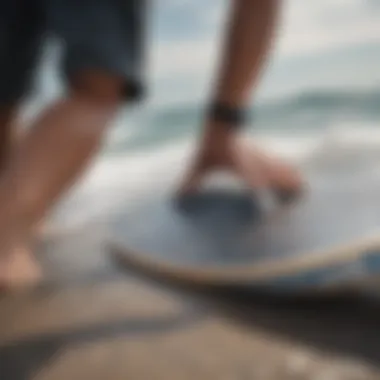
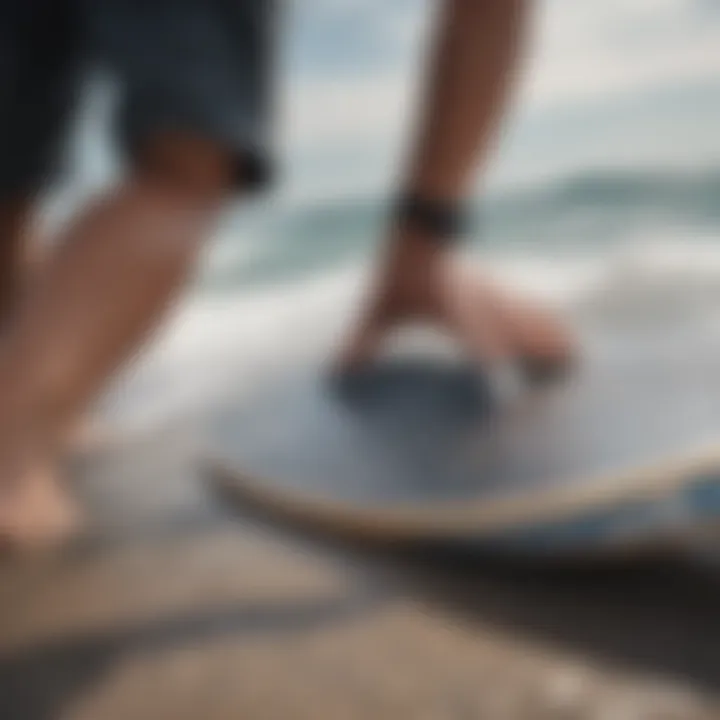
These tricks require not just skill but also an understanding of how grip tape interacts with the board and rider’s movements. Without adequate grip, a rider's control can wane and lead to serious falls. Moreover, adapting your technique based on the grip type can help refine these maneuvers, as different tapes react uniquely to movement.
Adjusting Technique Based on Grip Style
Different types of grip tape can change how you approach your skimboarding sessions. Depending on the texture and material, riders might find they need to adjust their techniques to maximize performance.
For example, higher grit grip tape is generally more aggressive, providing better traction. This may require the rider to shift their weight more carefully during spins to avoid unintended slips. On the other hand, smoother grip tapes might allow quicker transitions between tricks but can lead to less overall control. A rider might find they need to release their weight more when attempting tricks or expect the board to slip more easily.
To further enhance your performance, consider the following aspects:
- Foot Position: Understand how different grip types affect where your foot can go and how it acts during tricks.
- Weight Distribution: Adapting to the grip can shift where you place your weight when landing or during maneuvers.
- Traction Awareness: Recognizing the grip level can help determine how aggressively you can lean on turns or tricks.
"The choice of grip tape not only affects your control but also molds your entire riding style. It's essential to experiment with various types to discover what suits your technique best."
Environmental Considerations
With the growing awareness around sustainability, it's essential to discuss the environmental impact of grip tape used in skimboarding. This topic resonates particularly well with eco-conscious surfers and adventurers who wish to minimize their footprint while indulging in their favorite water sport. The choices made regarding grip tape can contribute significantly, not just to performance, but also to the ecological health of our beaches and oceans.
Sustainable Materials
When selecting grip tape, opting for sustainable materials is a no-brainer for any environmentally minded skimboarder. Many manufacturers are beginning to incorporate materials that lessen environmental impact. Examples range from natural rubbers to biodegradable adhesives.
- Recycled Content: Some brands have started to utilize recycled materials in their grip tape production. This reduces waste and conserves natural resources, which is a big win for our planet.
- Plant-Based Options: Plant-derived grips, made from renewable resources, provide a good alternative to conventional materials, which often rely on fossil fuel-derived plastics. These options tend to perform well while boosting an eco-friendly narrative.
- Non-Toxic Production: The processes used to create the grip tape can release harmful chemicals into the environment. Choosing manufacturers that use non-toxic production techniques helps safeguard both the planet and the health of users.
Using these sustainable materials not only assists the environment but also opens up a market for innovation. When companies shift their focus to eco-friendly practices, they often come up with technically superior products that enhance overall performance.
Recycling Options for Grip Tape
Once grip tape has served its purpose, what happens to it can affect the environment. Unfortunately, many users simply discard their worn grip tape without a second thought. However, awareness around recycling options can help change this narrative.
- Local Recycling Programs: Some surf shops and environmental organizations have started initiatives to recycle used grip tape. Before throwing it away, check if local stores or environmental groups accept used materials.
- DIY Reuse Projects: Innovative surfers are repurposing old grip tape, turning it into artisanal crafts like wallets or art pieces. This not only prevents waste but also promotes a culture of creativity and sustainability within the community.
- Education and Advocacy: Engaging with the community about proper ways to dispose of or recycle grip tape can foster a sense of collective responsibility. Social media platforms and forums are perfect for sharing tips and encouraging environmentally friendly practices.
"Every choice counts, even the tape on your skimboard. A small shift towards sustainability can yield significant positive environmental impacts."
Expert Insights
The incorporation of expert insights into discussions about grip tape in skimboarding significantly enhances the understanding of its critical importance. Pros and seasoned enthusiasts provide firsthand knowledge that transcends theoretical explanations. Their expertise, often accumulated through years of experience, covers not just the technicalities of grip tape selection but also nuances that can greatly affect performance and safety on the water.
Focusing on their real-world applications and preferences offers valuable perspectives for both newcomers and experienced riders looking to refine their gear choices. This section shall illuminate key elements such as:
- Personal Experiences: Insights from pro skimboarders about the particular grip tape they choose and why it works best for them.
- Technical Recommendations: Suggestions regarding grip type based on varying conditions, riding styles, and board materials.
- Safety Concerns: Understanding how different tapes can impact rider safety can be pivotal in preventing accidents and ensuring longevity in skimboarding experience.
Moreover, these professionals often speak to trends they have noticed within the skimboarding community—highlighting innovations in grip tape technology or shifts in preferred styles reflecting the evolving nature of the sport.
Interviews with Professional Skimboarders
When you reach out to professional skimboarders, you quickly realize their grip tape choices are often more than just personal preferences; they are a blend of practicality and experience honed through countless hours on the waves. For instance, Mike O'Connell, a well-known figure in the skimboarding scene, shared how he swears by a specific anti-slip variant for its superior traction. He emphasized,
"When you’re hitting a wave, the last thing you want to worry about is losing your footing. It can make or break a trick!"
Similarly, many pros mentioned experimenting with different grip textures to assess how they affected their ride in varying conditions. This kind of insight goes a long way to demystifying the intricacies of selecting the right product. Riders can better determine how certain materials can lead them to success or frustration.
Community Recommendations and Tips
The skimboarding community thrives on shared knowledge. Engaging in discussion forums or within local groups reveals a treasure trove of recommendations that can assist both novices and seasoned riders in navigating their grip tape choices. Here are notable tips aggregated from social conversations and Reddit discussions about grip tape:
- Selecting Based on Environment: Riders often suggest that choosing a grip tape suited for your climate can enhance performance. If you typically skim in humid, salty conditions, look for materials designed to withstand moisture without losing stickiness.
- Customization for Comfort: Many users recommend customizing grip tape with their own added textures or layering to suit their unique riding style. This can involve sanding down certain areas for finer feedback beneath your feet.
- Frequent Observations: Skimboarders stress the importance of regularly checking grip tape conditions. If you notice peeling or reduced stickiness, it might be time for a change to prevent accidents.
Finale
Grip tape might seem like a simple addition to a skimboard, yet its impact reverberates throughout the entire skimboarding experience. This article has taken us through the various dimensions of grip tape—its history, types, and undeniable role in enhancing safety and performance. Without question, grip tape is not just a stick-on accessory; it’s a fundamental part of how afty the board feels underfoot, how tricks are executed, and how riders maintain their footing through slippery conditions.
To recap, we have uncovered insightful details about the characteristics of grip tape that matter: from the different types available, such as eco-friendly options and anti-slip variants, to understanding how these features correlate with the skimboard material and riding style. The relationship between grip tape, control, and safety has been emphasized, affirming that a well-selected grip tape can reduce hazards and elevate the thrill of the ride.
"The right grip tape can mean the diference between a wave conquered and a face plant in the sand."
We’ve also explored the best practices for installing and maintaining grip tape, underscoring that a little care can extend the life of the tape significantly. By immersing ourselves in the nuances of these aspects, it becomes clear: one’s choice in grip tape can directly affect performance and rider confidence.
As skimboarding evolves, so too do the materials and technologies used in grip tape. The call for sustainability is loud and clear, and the industry is responding. Eco-friendly options allow riders to embrace their passion without compromising environmental values.
Ultimately, this article demonstrates how a small yet essential component like grip tape plays a crucial role in enhancing one’s skimboarding experience. The intricate relationship between rider, board, and waves dances on the surface of that grip tape. As adventurers set out to ride the waves, choosing the right grip tape is not an afterthought—it's a necessity.















